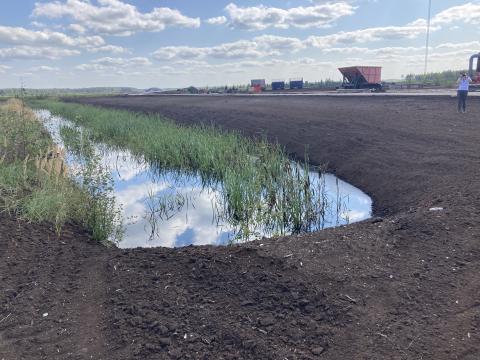RIWET in Riga
During a full day of site visits we witnessed three of Latvia’s best practice examples.
Waste management & water protection
First stop was the Getlini Eko landfill area. It’s inspirational to see how, by tackling the waste management processes here, there are positive impacts on water quality in the nearby river Daugava. Getlini began as a waste site in 1973 where all categories of waste were dumped onto a bog without any soil preparation. This poor environmental choice led to groundwater pollution in shallow aquifers, heading for the Daugava River. When Latvia joined the EU in 2004, the country took steps to protect water resources and comply with EU water directives.
Today, Getliņi EKO has made significant efforts to protect groundwater and surface water, with protective geotextile and clay layers around disposal sites, a wastewater collection and treatment system. The old waste was divided into biodegradation cells and covered with clay layers. Around 170 deep wells have been installed to capture gases. These gases now produce heat. Getliņi EKO focuses on recycling, considering waste as a resource, and educating the public about environmental issues. Sheep graze to maintain the grounds, energy from waste powers greenhouses and waste has become a resource, demonstrating sustainable innovation.
Innovative bog reclamation
During the second stop in the study tour, Normunds Stivrins from the University of Latvia guided us through the peatland area of the Kaigu Bog, near Jelgava, showing some innovative peatland recultivation methods. Here our knowledge partners are working in close collaboration with Latflora, a leading peat company and major European player in the production of substrates for ecosystems. Together they are aiming to reduce CO2 emissions and support green, sustainable business development.
The company is also boosting paludiculture, addressing a shift in the hydrological system and cooperation with scientific researchers to develop various reclamation methods, These iinvolve: establishing pine plantations for forest growth, cultivating lingonberries, and growing rhododendrons, heathers, and sedges. They also include beekeeping, paludiculture, and growing highbush blueberries and large cranberries. This was particularly interesting for a number of partners who want to learn more about this particular approach to reclamation. Future plans being investigated also involve building a wind-solar park and a green industrial zone in the Kaigu Bog.

Spring monitoring, citizen engagement
Finally, our Latvian colleagues Inga Retike and Jānis Bikše highlighted a great example of community engagement with their Spring Monitoring project to improve groundwater resources management. Jānis told us how volunteers map springs to provide missing data for scientists and water managers to improve cross-border monitoring networks.
Springs are natural groundwater outflows reflecting watershed conditions regarding pollution and groundwater resources. Since 2004, springs have been part of Latvia's national groundwater monitoring, supporting the EU Water Framework and Groundwater Directives. Springs are often used for drinking water due and support groundwater-dependent ecosystems like rivers and wetlands.
The lack of monitoring sites, especially in cross-border areas is a major challenge in groundwater management. Springs offer lower sampling and maintenance costs, representing larger catchments and making them ideal for monitoring networks. Their accessibility enables a rapid, cost-effective setup of transboundary networks. However, representative springs must be mapped and selected based on in-depth seasonal studies.
Within the WaterAct project, part of the Interreg V-A Estonia-Latvia cross-border cooperation programme, researchers organized voluntary monitoring to map new springs and identify representative ones using a web-based application launched in 2021. The app is used to collect information of known and new springs, offering clear guidelines for voluntary participation (avoti.info - Latvian).

“Over 200 users have joined the application, contributing to a database of over 3,000 springs, including approximately 600 previously unknown springs, “ Jānis explained. “This valuable data source has been recognized by national water authorities and contributes to future groundwater studies and national assessments required for implementing EU water directives. It’s important - an informed society can drive more actions at local, national, and international levels, resulting in new research, improved monitoring, and more sustainable water policies.”
Following such inspirational visits, the consortium strengthened its collaboration further by taking a restorative paddle together in the Gulf of Riga. With bags full of shared experiences, we look forward to learning more about regional challenges and best practices. Next stop Valencia!

